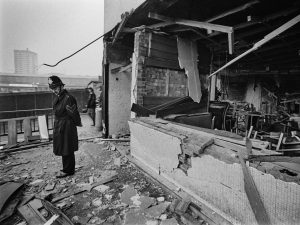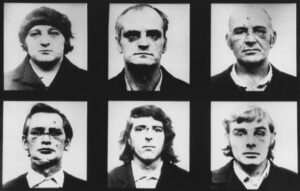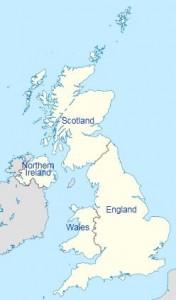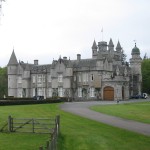northern ireland

 No disease, especially those that are highly contagious, and for which there is no known cure, is easy to find out that one has, and for those who might have been around the victim of said disease, it can be very frightening. Mary Mallon, who was born September 23, 1869, Cookstown, County Tyrone, Northern Ireland, immigrated to the United States in 1883. Possessing minimal skills, she made her living as a domestic servant, most often as a cook. At some point, she became a carrier of the typhoid bacterium (Salmonella typhi), although no one really knows exactly when or how that happened. Nevertheless, between 1900 and 1907, nearly two dozen people fell ill with typhoid fever in households in New York City and Long Island where Mallon worked. That was the first clue that she was a carrier, because the illnesses often occurred shortly after she began working in each household, then by the time the disease was traced to its source in a household where she had recently been employed, Mallon had already moved on, with no forwarding address. The whole dilemma made it very hard to really track down the carrier, and she knew nothing about it, because she wasn’t ill. It is unusual to be asymptomatic, but not impossible, and Typhoid Mary was one of the unusual ones.
No disease, especially those that are highly contagious, and for which there is no known cure, is easy to find out that one has, and for those who might have been around the victim of said disease, it can be very frightening. Mary Mallon, who was born September 23, 1869, Cookstown, County Tyrone, Northern Ireland, immigrated to the United States in 1883. Possessing minimal skills, she made her living as a domestic servant, most often as a cook. At some point, she became a carrier of the typhoid bacterium (Salmonella typhi), although no one really knows exactly when or how that happened. Nevertheless, between 1900 and 1907, nearly two dozen people fell ill with typhoid fever in households in New York City and Long Island where Mallon worked. That was the first clue that she was a carrier, because the illnesses often occurred shortly after she began working in each household, then by the time the disease was traced to its source in a household where she had recently been employed, Mallon had already moved on, with no forwarding address. The whole dilemma made it very hard to really track down the carrier, and she knew nothing about it, because she wasn’t ill. It is unusual to be asymptomatic, but not impossible, and Typhoid Mary was one of the unusual ones.
Finally, in 1906, after 6 people in a household of 11 where Mallon had worked in Oyster Bay, New York, became sick with typhoid, the home’s owners hired New York City Department of Health sanitary engineer George Soper to investigate the outbreak. Soper’s specialty was studying typhoid fever epidemics, so he was just the man for the job. Of course, Soper was not the only investigator looking for the carrier of the dreaded typhoid disease. Typhoid can usually be cured these days using medications like Ciprofloxacin and Ceftriaxone, but in those days, it meant a death sentence for many people. As the investigation continued, it was concluded that the outbreak had likely been caused by contaminated water. Mallon continued to work as a cook, moving from household to household until 1907. Finally in the right place at the right time, Mallon was located working in a Park Avenue home in Manhattan. The winter of that year, following an outbreak in the Manhattan household that involved a death from the disease, Soper met with Mallon. Following extensive tests, he linked all 22 cases of typhoid fever that had been recorded in New York City and the Long Island area to her. It was this connection that earner her the “unwanted” nickname of Typhoid Mary.
A scared Mallon fled the area, but authorities led by Soper finally overtook her and had her committed to an isolation center on North Brother Island, which is a part of the Bronx, New York. There she stayed, despite an appeal to the US Supreme Court. She was finally released in 1910, when the health department released her on condition that she never again accept employment that involved the handling of food. These days she might have been able to go back to work as a cook, but at that time they couldn’t successfully test for the presence of the bacteria in a person, and with the very real possibility of passing the contagion through food, it was a risk they couldn’t take.
Unfortunately for Mallon, an epidemic four years later, brought her once again into the spotlight. The epidemic 
 was at a sanatorium in Newfoundland, New Jersey, and at Sloane Maternity Hospital in Manhattan. Mallon had worked as a cook at both places. Mallon was at last found in a suburban home in Westchester County, New York, and was returned to North Brother Island, where she remained for the rest of her life. In 1932, she suffered a paralytic stroke that led to her slow death six years later.
was at a sanatorium in Newfoundland, New Jersey, and at Sloane Maternity Hospital in Manhattan. Mallon had worked as a cook at both places. Mallon was at last found in a suburban home in Westchester County, New York, and was returned to North Brother Island, where she remained for the rest of her life. In 1932, she suffered a paralytic stroke that led to her slow death six years later.
Mallon claimed to have been born in the United States, but it was later determined that she was an immigrant. Although she herself was immune to the typhoid bacillus, 51 original cases of typhoid and three deaths were directly attributed to Typhoid Mary. There were also countless more that were indirectly attributed to her as people she infected, passed the illness to people they came in contact with.
 On November 21, 1974, after two Irish Republican Army (IRA) bombs exploded in two separate Birmingham pubs, killing 21 people and injuring hundreds, an investigation was opened to find the culprits. Almost immediately, the investigation centered on six men, later known as the Birmingham Six. For years the IRA and the British government had been at odds over the status of Northern Ireland, in fact you had to be hiding under a rock if you didn’t know about it. Still, on that November day, it all came to a head. The bombs exploded, destroying everything and killing or hurting everyone in sight.
On November 21, 1974, after two Irish Republican Army (IRA) bombs exploded in two separate Birmingham pubs, killing 21 people and injuring hundreds, an investigation was opened to find the culprits. Almost immediately, the investigation centered on six men, later known as the Birmingham Six. For years the IRA and the British government had been at odds over the status of Northern Ireland, in fact you had to be hiding under a rock if you didn’t know about it. Still, on that November day, it all came to a head. The bombs exploded, destroying everything and killing or hurting everyone in sight.
The most immediate reaction of the British government was to outlaw the IRA. Virtually overnight, they were declared a terrorist group in all the United Kingdom. Thus began the worst miscarriage of justice in British history. Immediately, authorities rushed to arrest and convict the IRA members who were responsible for these horrific acts. Six Irish suspects were picked up. They were Hugh Callaghan, Patrick Joseph Hill, Gerard Hunter, Richard McIlkenny, William Power, and John Walker. During interrogation, four of the men signed confessions, which made no sense, because even the IRA, which had claimed responsibility for the Birmingham bombings, said that the six were not members of its organization.
That begs the question, that if the IRA claimed responsibility and specifically said these men were part of their organization, how could these men be tried, found guilty, and sentenced. Nevertheless, they were, and they  served 16 years before something was done about it. These men declared their innocence almost from the beginning…if you take the signed confessions at face value, and assume they were not coerced. The men stated and never wavered, that the police had beaten the confessions out of them. Many people would agree. Of course, the prosecutors denied this and also came up with forensic evidence that apparently proved that the Birmingham Six had handled explosives shortly before their arrest. It appeared that they just wanted to get a conviction so things could settle down. I’m sure they were under a lot of pressure to solve the crime.
served 16 years before something was done about it. These men declared their innocence almost from the beginning…if you take the signed confessions at face value, and assume they were not coerced. The men stated and never wavered, that the police had beaten the confessions out of them. Many people would agree. Of course, the prosecutors denied this and also came up with forensic evidence that apparently proved that the Birmingham Six had handled explosives shortly before their arrest. It appeared that they just wanted to get a conviction so things could settle down. I’m sure they were under a lot of pressure to solve the crime.
Following their convictions, the men were sentenced to lengthy prison terms. In all they spent 16 years in prison, before something changed. I’m sure they thought they would never be free again, but their convictions were declared “unsafe and unsatisfactory” and quashed by the Court of Appeal on 14 March 1991. Apparently, this all came about as a result of the widespread questioning of their guilt by the British people. They started seeing that things just didn’t add up, and yet, here were these men, locked up and seemingly innocent of any crime. In the face of all this, the British authorities released the so-called “Birmingham Six.” The six Irish men who had been sent to prison 16 years earlier for the 1974 terrorist bombings of two pubs in Birmingham, England. To further prove the error, in 1985, the forensic evidence was exposed by scientists as unreliable at best!! The nightmare for the Birmingham Six was coming to an end, and the nightmare for the British government was just beginning. In 1987 an appeals judge conceded that the same results could be obtained  from testing people who recently touched playing cards or cigarette paper, and yet these men were convicted of a bombing based on that same lack of credible evidence. Even with all that information, it took until March 1991, before the people across Britain and Ireland began calling for their release. Finally, they were freed after years in prison. They were free, but their story didn’t end there. Seven years later, a British court of appeals formally overturned their sentences, citing serious doubts about the legitimacy of the police evidence and the treatment of the suspects during their interrogation. The six men were later awarded compensation ranging from £840,000 to £1.2 million.
from testing people who recently touched playing cards or cigarette paper, and yet these men were convicted of a bombing based on that same lack of credible evidence. Even with all that information, it took until March 1991, before the people across Britain and Ireland began calling for their release. Finally, they were freed after years in prison. They were free, but their story didn’t end there. Seven years later, a British court of appeals formally overturned their sentences, citing serious doubts about the legitimacy of the police evidence and the treatment of the suspects during their interrogation. The six men were later awarded compensation ranging from £840,000 to £1.2 million.
 Many people may not be aware that in the United Kingdom of Great Britain, there is almost a constant state of confusion over just exactly who they are. They are considered Great Britain or the United Kingdom, but the United Kingdom takes in the countries of England, Scotland, Wales and Northern Ireland. It was on this day May 1, 1707 that England and Scotland joined together to become the United Kingdom. I think the union must have been a bit surprising, given that the English and the Scots had long battled over one thing or another. Nevertheless, The Scots needed the economic support that England could offer, while for England the merger was political. The Scots would no longer have a Parliment, but they were given instead a proportion of the seats at Westminster.
Many people may not be aware that in the United Kingdom of Great Britain, there is almost a constant state of confusion over just exactly who they are. They are considered Great Britain or the United Kingdom, but the United Kingdom takes in the countries of England, Scotland, Wales and Northern Ireland. It was on this day May 1, 1707 that England and Scotland joined together to become the United Kingdom. I think the union must have been a bit surprising, given that the English and the Scots had long battled over one thing or another. Nevertheless, The Scots needed the economic support that England could offer, while for England the merger was political. The Scots would no longer have a Parliment, but they were given instead a proportion of the seats at Westminster.
The English tend to call Great Britain, England, with notorious disregard for the feelings of the Welsh, with whom they joined in 1536 and the Scots, with whom they joined in 1707. The Act of Union of 1707, states merely that England and Scotland shall ‘be united into one kingdom by the name of Great Britain’. Many people simply lumped them together as Britain, calling all of them the Brits, which technically isn’t so…and even the English didn’t like that name. The last official merger was with Northern Ireland in 1800, at which time the enlarged kingdom became the United Kingdom of Great Britain.
It’s hard for me to think about being a country that is part of a kingdom, and yet, I suppose that is exactly what we were when the United States of America was part of England. Although we may not have been considered a part of a kingdom exactly, we were under British rule until the Revolutionary War. I suppose that there could be a love/hate relationship among the countries of the United Kingdom to this day. I do think that the British Royals do like to go to the different countries that are a part of the United Kingdom, and maybe 
 those countries like having them come for a visit now, but I have to wonder if that was always the case. Queen Elizabeth heads to her Scottish castle, Balmoral, at this time of the year, so she must love the whole Scottish countryside at least almost as much as she does England. For Queen Elizabeth, having a castle in Scotland is normal. I suppose that if you grew up being a part of a kingdom, it would be normal, and in all reality, while it wasn’t always a kingdom, it has been since 1536, so it might as well have been always…at least for the people who call the United Kingdom of Great Britain home.
those countries like having them come for a visit now, but I have to wonder if that was always the case. Queen Elizabeth heads to her Scottish castle, Balmoral, at this time of the year, so she must love the whole Scottish countryside at least almost as much as she does England. For Queen Elizabeth, having a castle in Scotland is normal. I suppose that if you grew up being a part of a kingdom, it would be normal, and in all reality, while it wasn’t always a kingdom, it has been since 1536, so it might as well have been always…at least for the people who call the United Kingdom of Great Britain home.

